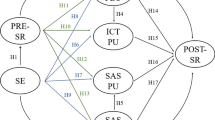Abstract
This study investigated the impact of a self-regulatory tool, the Instructional Planning Self-Reflective Tool (IPSRT), on preservice teachers' performance, disposition, and self-efficacy beliefs regarding systematic instructional planning. Participants enrolled in an introductory educational technology course were taught how to develop an instructional plan as part of the course. An experimental group was provided with instruction on how to use the IPSRT while engaging in instructional planning. Results indicated that the experimental group demonstrated greater skill acquisition, showed more positive disposition, and reported higher perceived instrumentality of instructional planning. In terms of self-efficacy, no significant differences were found between the two groups. However, further analyses revealed that participants who were initially high in self-efficacy reported significantly lower self-efficacy following the tool intervention; in contrast, participants initially low in self-efficacy showed significantly higher self-efficacy following the tool intervention. Findings are discussed from a social-cognitive perspective.
Similar content being viewed by others
References
Bandura, A. (1986).Social foundations of thought and action: A social-cognitive theory. Englewood Cliffs, NJ: Prentice Hall.
Bandura, A. (1997).Self-efficacy: The exercise of control. New York: W.H. Freeman.
Bandura, A., & Schunk, D.H. (1981). Cultivating competence, self-efficacy, and intrinsic interest through proximal self-motivation.Journal of Personality and Social Psychology, 41, 586–598.
Baylor, A.L., Kitsantas, A., & Chung, H. (2001). The Instructional Planning Self-Reflective Tool (IPSRT): A method for promoting effective lesson planning.Educational Technology 41 (2), 56–59.
Dick, W., & Carey, L. (1996).The systematic design of instruction. Addison-Wesley, Longman.
Dick, W., & Reiser, R.A. (1989).Planning effective instruction, NJ: Englewood Cliffs.
Driscoll, M.P., Klein, J., & Sherman, G. (1994). Perspectives on instructional planning: How do teachers and instructional designers conceive of ISD planning practices?Educational Technology, 34(3), 34–42.
Kagan, D., & Tippins, D. (1992). The evolution of functional lessons among twelve elementary and secondary student teachers.Elementary School Journal, 92(4), 477–489.
Kitsantas, A. (2000). The role of self-regulation strategies and self-efficacy perceptions in successful weight loss maintenance.Psychology & Health, An International Journal, 15, 811–820.
Kitsantas, A., & Zimmerman, B.J. (1998). Self-regulation of motoric learning: A strategic cycle view.Journal of Applied Sport Psychology, 10, 220–239.
Mace, F., Belfiore, P., & Shea, M. (1989). Operant theory and research on self-regulation. In B.J. Zimmerman & D.H. Shunk (Eds.),Self regulated learning and academic achievement: Theory, research, and practice (pp. 27–50). New York: Springer-Verlag.
Martin, B. (1990). Teachers' planning processes: Does ISD make a difference?Performance Improvement Quarterly, 3(4), 53–73.
Moallem, M. (1998). An expert teacher's thinking and teaching and instructional design models and principles: An ethnographic study.Educational Technology Research and Development, 46(2), 37–64.
Neale, D.C., Pace, A.J., & Case, A.B. (April, 1983).The influence of training experience, and organizational environment on teachers' use of the systematic planning model. Paper presented at the annual meeting of American Educational Research Association, Montreal, Canada.
Reiser, R.A. (1994). Examining the planning practices of teachers: Reflections on three years of research.Educational Technology, 34(3), 11–16.
Reiser, R.A., & Dick, W. (1996).Instructional planning: A guide for teachers. Allyn and Bacon.
Reynolds, A. (1993). What is competent beginning teaching? A review of the literature.Review of Educational Research, 62, 1–36.
Schunk, D.H. (1983). Progress of self-monitoring: Effects on children's self-efficacy and achievement.Journal of Experimental Education, 51, 89–93.
Schunk, D.H. (1989). Social cognitive theory and self-regulated learning. In B.J. Zimmerman & D.H. Schunk (Eds.),Self-regulated learning and academic achievement: Theory, research, and practice (pp. 83–110). New York: Springer-Verlag.
Schunk, D.H. (1996). Goal and self-evaluative influences during children's cognitive skill learning.American Educational Research Journal, 33, 359–382.
Seels, B.A., & Glasgow, Z. (1990).Exercises in instructional design. Columbus, OH: Merrill Publishing.
Young, A.C., Reiser, R.A., & Dick, W. (1998). Do superior teachers employ systematic instructional planning procedures? A descriptive study.Educational Technology Research and Development, 46(2), 65–78.
Zimmerman, B.J. (2000). Attaining self-regulation: A social cognitive perspective. In: M. Boekaerts, P. Pintrich & M. Seidner (Eds.),Self-regulation: Theory, research and applications. Orlando, FL: Academic Press.
Zimmerman, B.J., & Bandura, A. (1994). Impact of self-regulatory influences on writing course attainment.American Educational Research Journal, 31, 845–862.
Zimmerman, B.J., & Kitsantas, A. (1999). Acquiring writing revision skill: Shifting from process to out-come self-regulatory goals.Journal of Educational Psychology, 91(2), 241–250.
Author information
Authors and Affiliations
Rights and permissions
About this article
Cite this article
Kitsantas, A., Baylor, A. The impact of the instructional planning self-reflective tool on preservice teacher performance, disposition, and self-efficacy beliefs regarding systematic instructional planning. ETR&D 49, 97–106 (2001). https://doi.org/10.1007/BF02504949
Issue Date:
DOI: https://doi.org/10.1007/BF02504949




